Antimicrobial Use in Animals in Timor-Leste Based on Veterinary Antimicrobial Imports between 2016 and 2019
Abstract
1. Introduction
2. Materials and Methods
2.1. Data Collection for Antimicrobial Imports
2.2. Data Categorisation for Antimicrobial Imports
2.3. Animal Biomass Calculation
2.4. Data Analysis
2.5. Ethical Approval
3. Results
3.1. Import Quantities and Trends
3.2. Import Pattern by Recommended Route of Administration
3.3. Import Pattern by Importer Type
4. Discussion
4.1. Strengths of the Study
4.2. Quantity of Antimicrobial Import
4.3. Trend of Antimicrobial Import
4.4. Antimicrobial Class and Importance for Human Medicine
4.5. Route of Administration
4.6. Use of Antimicrobials for Growth Promotion
4.7. Use of Antimicrobials in Aquaculture
4.8. Limitations
4.9. Future Directions
5. Conclusions
Supplementary Materials
Author Contributions
Funding
Institutional Review Board Statement
Informed Consent Statement
Data Availability Statement
Acknowledgments
Conflicts of Interest
References
- Robinson, T.P.; Bu, D.P.; Carrique-Mas, J.; Fèvre, E.M.; Gilbert, M.; Grace, D.; Hay, S.I.; Jiwakanon, J.; Kakkar, M.; Kariuki, S.; et al. Antibiotic resistance is the quintessential One Health issue. Trans. R. Soc. Trop Med. Hyg. 2016, 110, 377–380. [Google Scholar] [CrossRef]
- Léger, A.; Lambraki, I.; Graells, T.; Cousins, M.; Henriksson, P.J.G.; Harbarth, S.; Carson, C.; Majowicz, S.; Troell, M.; Parmley, E.J.; et al. AMR-Intervene: A social–ecological framework to capture the diversity of actions to tackle antimicrobial resistance from a One Health perspective. J. Antimicrob. Chemother. 2021, 76, 1–21. [Google Scholar] [CrossRef]
- Wall, B.A.; Mateus, A.L.P.; Marshall, L.; Pfeiffer, D.U.; Lubroth, J.; Ormel, H.J.; Otto, P.; Patriarchi, A. Drivers, Dynamics and Epidemiology of Antimicrobial Resistance in Animal Production. Available online: http://www.fao.org/feed-safety/resources/resources-details/en/c/452608/ (accessed on 16 February 2021).
- Lim, K.; Chee, D.; Ting, S.; Choo, E.; Tan, W.L.; Lin, Y.N. Singapore’s National Action Plan on Antimicrobial Resistance. Asian Fish. Sci. 2020, 33, 107–111. [Google Scholar] [CrossRef]
- Tang, K.L.; Caffrey, N.P.; Nóbrega, D.B.; Cork, S.C.; Ronksley, P.E.; Barkema, H.W.; Polachek, A.J.; Ganshorn, H.; Sharma, N.; Kellner, J.D.; et al. Restricting the use of antibiotics in food-producing animals and its associations with antibiotic resistance in food-producing animals and human beings: A systematic review and meta-analysis. Lancet Planet. Health 2017, 1, e316–e327. [Google Scholar] [CrossRef]
- Ventola, C.L. The antibiotic resistance crisis: Part 1: Causes and threats. Pharm. Ther. 2015, 40, 277–283. [Google Scholar]
- Klein, E.; Boeckel, T.; Martinez, E.; Pant, S.; Gandra, S.; Levin, S.; Goossens, H.; Laxminarayan, R. Global increase and geographic convergence in antibiotic consumption between 2000 and 2015. Proc. Natl. Acad. Sci. USA 2018, 115, 201717295. [Google Scholar] [CrossRef]
- Animal Production ScienceVan Boeckel, T.P.; Brower, C.; Gilbert, M.; Grenfell, B.T.; Levin, S.A.; Robinson, T.P.; Teillant, A.; Laxminarayan, R. Global trends in antimicrobial use in food animals. Proc. Natl. Acad. Sci. USA 2015, 112, 5649–5654. [Google Scholar] [CrossRef] [PubMed]
- Van Boeckel, T.P.; Glennon, E.E.; Chen, D.; Gilbert, M.; Robinson, T.P.; Grenfell, B.T.; Levin, S.A.; Bonhoeffer, S.; Laxminarayan, R. Reducing antimicrobial use in food animals. Science 2017, 357, 1350. [Google Scholar] [CrossRef]
- Tiseo, K.; Huber, L.; Gilbert, M.; Robinson, T.P.; Van Boeckel, T.P. Global Trends in Antimicrobial Use in Food Animals from 2017 to 2030. Antibiotics (Basel) 2020, 9, 918. [Google Scholar] [CrossRef] [PubMed]
- BelVet-SAC. Belgium Veterinary Surveillance of Antimicrobial Consumption: National Consumption Report 2019. Available online: https://belvetsac.ugent.be/BelvetSac_report_2019.pdf (accessed on 21 February 2021).
- ANSES-ANMV. Sales Survey of Veterinary Medicinal Products Containing Antimicrobials in France in 2019. Available online: https://www.anses.fr/en/system/files/ANMV-Ra-Antibiotiques2019EN.pdf (accessed on 21 February 2021).
- Swedres-Svarm. Sales of Antibiotics and Occurrence of Resistance in Sweden 2019. Available online: https://www.folkhalsomyndigheten.se/contentassets/fb80663bc7c94d678be785e3360917d1/swedres-svarm-2019.pdf (accessed on 21 February 2021).
- UK-VARSS. Veterinary Antibiotic Resistance and Sales Surveillance Report (UK-VARSS 2019). Available online: https://assets.publishing.service.gov.uk/government/uploads/system/uploads/attachment_data/file/950126/UK-VARSS_2019_Report__2020-TPaccessible.pdf (accessed on 20 February 2021).
- National Food Institute; Statens Serum Institut. DANMAP 2019—Use of Antimicrobial Agents and Occurrence of Antimicrobial Resistance in Bacteria from Food Animals, Food and Humans in Denmark. Available online: https://www.danmap.org/-/media/Sites/danmap/Downloads/Reports/2019/DANMAP_2019.ashx?la=da&hash=AA1939EB449203EF0684440AC1477FFCE2156BA5 (accessed on 21 February 2021).
- Van Boeckel, T.P.; Pires, J.; Silvester, R.; Zhao, C.; Song, J.; Criscuolo, N.G.; Gilbert, M.; Bonhoeffer, S.; Laxminarayan, R. Global trends in antimicrobial resistance in animals in low- and middle-income countries. Science 2019, 365, 1944. [Google Scholar] [CrossRef] [PubMed]
- Goutard, F.L.; Bordier, M.; Calba, C.; Erlacher-Vindel, E.; Góchez, D.; de Balogh, K.; Benigno, C.; Kalpravidh, W.; Roger, F.; Vong, S. Antimicrobial policy interventions in food animal production in South East Asia. BMJ 2017, 358, j3544. [Google Scholar] [CrossRef]
- Ström, G.; Halje, M.; Karlsson, D.; Jiwakanon, J.; Pringle, M.; Fernström, L.L.; Magnusson, U. Antimicrobial use and antimicrobial susceptibility in Escherichia coli on small- and medium-scale pig farms in north-eastern Thailand. Antimicrob. Resist. Infect. Control 2017, 6, 75. [Google Scholar] [CrossRef] [PubMed]
- O’Neill, J. Tackling Drug-Resistant Infections Globally: Final Report and Recommendations; Government of the United Kingdom: London, UK, 2016.
- Laxminarayan, R.P.; Duse, A.M.D.; Wattal, C.M.D.; Zaidi, A.K.M.M.D.; Wertheim, H.F.L.M.D.; Sumpradit, N.P.; Vlieghe, E.M.D.; Hara, G.L.P.; Gould, I.M.M.; Goossens, H.P.; et al. Antibiotic resistance—The need for global solutions. Lancet Infect. Dis. 2013, 13, 1057–1098. [Google Scholar] [CrossRef]
- World Health Organization. Global Action Plan on Antimicrobial Resistance; World Health Organization: Geneva, Switzerland, 2015. [Google Scholar]
- World Organisation for Animal Health (OIE). Terrestrial Animal Health Code: Chapter 6.9 Monitoring of the Quantities and Usage Patterns of Antimicrobial Agents Used in Food-Producing Animals. Available online: https://www.oie.int/index.php?id=169&L=0&htmfile=chapitre_antibio_monitoring.htm (accessed on 16 February 2021).
- Chantziaras, I.; Boyen, F.; Callens, B.; Dewulf, J. Correlation between veterinary antimicrobial use and antimicrobial resistance in food-producing animals: A report on seven countries. J. Antimicrob. Chemother. 2014, 69, 827–834. [Google Scholar] [CrossRef]
- Callens, B.; Cargnel, M.; Sarrazin, S.; Dewulf, J.; Hoet, B.; Vermeersch, K.; Wattiau, P.; Welby, S. Associations between a decreased veterinary antimicrobial use and resistance in commensal Escherichia coli from Belgian livestock species (2011–2015). Prev. Vet. Med. 2018, 157, 50–58. [Google Scholar] [CrossRef] [PubMed]
- Góchez, D.; Raicek, M.; Pinto Ferreira, J.; Jeannin, M.; Moulin, G.; Erlacher-Vindel, E. OIE Annual Report on Antimicrobial Agents Intended for Use in Animals: Methods Used. Front. Vet. Sci. 2019, 6. [Google Scholar] [CrossRef]
- Grave, K.; Torren-Edo, J.; Mackay, D. Comparison of the sales of veterinary antibacterial agents between 10 European countries. J. Antimicrob. Chemother. 2010, 65, 2037–2040. [Google Scholar] [CrossRef]
- Hosoi, Y.; Asai, T.; Koike, R.; Tsuyuki, M.; Sugiura, K. Use of veterinary antimicrobial agents from 2005 to 2010 in Japan. Int. J. Antimicrob. Agents 2013, 41, 489–490. [Google Scholar] [CrossRef]
- Page, S.W.; Gautier, P. Use of antimicrobial agents in livestock. Rev. Sci. Tech. OIE 2012, 31, 145–188. [Google Scholar] [CrossRef]
- World Organisation for Animal Health (OIE). OIE Annual Report on Antimicrobial Agents Intended for Use in Animals. Fourth report. Available online: https://www.oie.int/fileadmin/Home/eng/Our_scientific_expertise/docs/pdf/AMR/A_Fourth_Annual_Report_AMR.pdf (accessed on 16 February 2021).
- The World Bank. World Bank Country and Lending Groups. Available online: https://datahelpdesk.worldbank.org/knowledgebase/articles/906519 (accessed on 16 February 2021).
- The World Bank. Population, Total—Timor-Leste. Available online: https://data.worldbank.org/indicator/SP.POP.TOTL?locations=TL (accessed on 16 February 2021).
- General Directorate of Statistics—Ministry of Finance (Timor Leste) and ICF. Timor-Leste Demographic and Health Survey 2016; GDS and ICF: Dili, Timor-Leste, 2018. [Google Scholar]
- Lundahl, M.; Sjöholm, F. Improving the Lot of the Farmer: Development Challenges in Timor-Leste during the Second Decade of Independence. Asian Econ. Pap. 2013, 12, 71–96. [Google Scholar] [CrossRef]
- Bettencourt, E.; Tilman, M.; Narciso, V.; Da Silva Carvalho, M.L.; Henriques, P. The Livestock Roles in the Wellbeing of Rural Communities of Timor-Leste. Revista de Economia e Sociologia Rural 2015, 53, 63–80. [Google Scholar] [CrossRef]
- General Directorate of Statistics—Ministry of Finance (Timor Leste); Food and Agriculture Organization of the United Nations (FAO); United Nations Population Fund (UNFPA). Timor-Leste Population and Housing Census 2015: Thematic Report Volume 12; Government of Timor-Leste: Canberra, Australia, 2018.
- Spencer, P.R.; Sanders, K.A.; Judge, D.S. Rural Livelihood Variation and its Effects on Child Growth in Timor-Leste. Hum. Ecol. 2018, 46, 787–799. [Google Scholar] [CrossRef]
- de Correia, V.P.; Rola-Rubzen, M.F. Breaking the poverty cycle through linking farmers to markets in Timor Leste: The World Vision income generation project. Hum. Dev. Capacit. Build. Asia Pac. Trends Chall. Prospect. Future 2016. [Google Scholar] [CrossRef]
- The Poultry Site. International Egg and Poultry Review: Timor-Leste. Available online: https://www.thepoultrysite.com/news/2011/06/international-egg-and-poultry-review-timorleste (accessed on 18 February 2021).
- World Organisation for Animal Health (OIE). OIE List of Antimicrobial Agents of Veterinary Importance (July 2019). Available online: https://www.oie.int/fileadmin/Home/eng/Our_scientific_expertise/docs/pdf/AMR/A_OIE_List_antimicrobials_July2019.pdf (accessed on 19 February 2021).
- Jong, J.B.D.C. Multi-Capacity Building for Antimicrobial Use (AMU) Data Collection: Improving the Recording of Antimicrobial Agents Intended for Use in Animals in Timor-Leste. Available online: https://rr-asia.oie.int/en/projects/antimicrobial-resistance/good-practices-addressing-amr-in-asia-and-the-pacific-region/multi-capacity-building-for-antimicrobial-use-amu-data-collection/ (accessed on 22 February 2021).
- World Organisation for Animal Health (OIE). Guidance for completing the OIE Template for the Collection of Data on Antimicrobial Agents Intended for Use in Animals (Version 1_Sept 2020). Available online: https://www.oie.int/fileadmin/Home/eng/Our_scientific_expertise/docs/pdf/AMR/2020/ENG_AMUse_Guidance_Final_2020.pdf (accessed on 19 February 2021).
- World Health Organization. Critically Important Antimicrobials for Human Medicine 6th Revision; World Health Organization: Geneva, Switzerland, 2019. [Google Scholar]
- Food and Agriculture Organization of the United Nations. Live Animals in Timor-Leste: Stocks. Available online: http://www.fao.org/faostat/en/#data/QA (accessed on 10 January 2021).
- Food and Agriculture Organization of the United Nations. Livestock Primary in Timor-Leste: Producing animals/slaughtered. Available online: http://www.fao.org/faostat/en/#data/QL (accessed on 10 January 2021).
- Hillerton, J.E.; Irvine, C.R.; Bryan, M.A.; Scott, D.; Merchant, S.C. Use of antimicrobials for animals in New Zealand, and in comparison with other countries. N. Z. Vet. J. 2017, 65, 71–77. [Google Scholar] [CrossRef] [PubMed]
- European Medicines Agency—European Surveillance of Veterinary Antimicrobial Consumption. Sales of Veterinary Antimicrobial Agents in 31 European Countries in 2018. Available online: https://www.ema.europa.eu/en/documents/report/sales-veterinary-antimicrobial-agents-31-european-countries-2018-trends-2010-2018-tenth-esvac-report_en.pdf (accessed on 16 February 2021).
- Alders, R.G.; Ali, S.N.; Ameri, A.A.; Bagnol, B.; Cooper, T.L.; Gozali, A.; Hidayat, M.M.; Rukambile, E.; Wong, J.T.; Catley, A. Participatory Epidemiology: Principles, Practice, Utility, and Lessons Learnt. Front. Vet. Sci. 2020, 7, 532763. [Google Scholar] [CrossRef] [PubMed]
- Serrao, E.A. Constraints to Production of Village Chickens in Timor-Leste. PhD Thesis, University of Queensland, Queensland, Australia, 2012. [Google Scholar]
- Om, C.; McLaws, M.-L. Antibiotics: Practice and opinions of Cambodian commercial farmers, animal feed retailers and veterinarians. Antimicrob. Resist. Infect. Control 2016, 5, 42. [Google Scholar] [CrossRef]
- Kiambi, S.; Mwanza, R.; Sirma, A.; Czerniak, C.; Kimani, T.; Kabali, E.; Dorado-Garcia, A.; Eckford, S.; Price, C.; Gikonyo, S.; et al. Understanding Antimicrobial Use Contexts in the Poultry Sector: Challenges for Small-Scale Layer Farms in Kenya. Antibiotics (Basel) 2021, 10, 106. [Google Scholar] [CrossRef]
- Jong, J.B.D.C.; (National Director of Veterinary Directorate, Ministry of Agriculture and Fisheries. Timor-Leste). Personal Communication. 2021. [Google Scholar]
- Democratic Republic of Timor-Leste. Decree-Law No. 3/2018 of March 14: About the Import Ban on Poultry and Poultry Products. Available online: http://extwprlegs1.fao.org/docs/pdf/tim187132.pdf (accessed on 19 February 2021).
- Jong, J.B.D.C. Scavenging for protein and micronutrients: Village poultry in Timor-Leste. Available online: https://www.crawfordfund.org/wp-content/uploads/2017/04/CF-2016-Conference-Proceedings-Jong.pdf (accessed on 22 February 2021).
- Conan, A.; Goutard, F.L.; Sorn, S.; Vong, S. Biosecurity measures for backyard poultry in developing countries: A systematic review. BMC Vet. Res. 2012, 8, 240. [Google Scholar] [CrossRef] [PubMed]
- Coyne, L.; Patrick, I.; Arief, R.; Benigno, C.; Kalpravidh, W.; McGrane, J.; Schoonman, L.; Sukarno, A.H.; Rushton, J. The Costs, Benefits and Human Behaviours for Antimicrobial Use in Small Commercial Broiler Chicken Systems in Indonesia. Antibiotics (Basel) 2020, 9, 154. [Google Scholar] [CrossRef]
- Kimera, Z.I.; Frumence, G.; Mboera, L.E.G.; Rweyemamu, M.; Mshana, S.E.; Matee, M.I.N. Assessment of Drivers of Antimicrobial Use and Resistance in Poultry and Domestic Pig Farming in the Msimbazi River Basin in Tanzania. Antibiotics (Basel) 2020, 9, 838. [Google Scholar] [CrossRef]
- Lhermie, G.; Gröhn, Y.T.; Raboisson, D. Addressing Antimicrobial Resistance: An Overview of Priority Actions to Prevent Suboptimal Antimicrobial Use in Food-Animal Production. Front. Microbiol. 2017, 7, 2114. [Google Scholar] [CrossRef]
- Ström, G.; Boqvist, S.; Albihn, A.; Fernström, L.L.; Andersson Djurfeldt, A.; Sokerya, S.; Sothyra, T.; Magnusson, U. Antimicrobials in small-scale urban pig farming in a lower middle-income country—Arbitrary use and high resistance levels. Antimicrob. Resist. Infect. Control 2018, 7, 35. [Google Scholar] [CrossRef]
- Nhung, N.T.; Cuong, N.V.; Thwaites, G.; Carrique-Mas, J. Antimicrobial Usage and Antimicrobial Resistance in Animal Production in Southeast Asia: A Review. Antibiotics (Basel) 2016, 5, 37. [Google Scholar] [CrossRef] [PubMed]
- Olatoye, O.; Afisu, B. Antibiotic Usage and Oxytetracycline Residue in African Catfish (Clarias gariepinus in Ibadan, Nigeria). World J. Fish. Mar. Sci. 2013, 5, 302–309. [Google Scholar] [CrossRef]
- Aktas, I.; Yarsan, E. Pharmacokinetics of Conventional and Long-Acting Oxytetracycline Preparations in Kilis Goat. Front. Vet. Sci. 2017, 4, 229. [Google Scholar] [CrossRef]
- Xu, J.; Sangthong, R.; McNeil, E.; Tang, R.; Chongsuvivatwong, V. Antibiotic use in chicken farms in northwestern China. Antimicrob. Resist. Infect. Control 2020, 9, 10. [Google Scholar] [CrossRef]
- Carrique-Mas, J.J.; Trung, N.V.; Hoa, N.T.; Mai, H.H.; Thanh, T.H.; Campbell, J.I.; Wagenaar, J.A.; Hardon, A.; Hieu, T.Q.; Schultsz, C. Antimicrobial usage in chicken production in the Mekong Delta of Vietnam. Zoonoses Public Health 2015, 62, 70–78. [Google Scholar] [CrossRef] [PubMed]
- Lekagul, A.; Tangcharoensathien, V.; Mills, A.; Rushton, J.; Yeung, S. How antibiotics are used in pig farming: A mixed-methods study of pig farmers, feed mills and veterinarians in Thailand. BMJ Glob. Health 2020, 5, e001918. [Google Scholar] [CrossRef] [PubMed]
- Aidara-Kane, A.; Angulo, F.J.; Conly, J.M.; Minato, Y.; Silbergeld, E.K.; McEwen, S.A.; Collignon, P.J.; Group, W.H.O.G.D. World Health Organization (WHO) guidelines on use of medically important antimicrobials in food-producing animals. Antimicrob. Resist. Infect. Control 2018, 7, 7. [Google Scholar] [CrossRef] [PubMed]
- Sommanustweechai, A.; Chanvatik, S.; Sermsinsiri, V.; Sivilaikul, S.; Patcharanarumol, W.; Yeung, S.; Tangcharoensathien, V. Antibiotic distribution channels in Thailand: Results of key-informant interviews, reviews of drug regulations and database searches. Bull. World Health Organ. 2018, 96, 101–109. [Google Scholar] [CrossRef]
- Tufa, T.B.; Gurmu, F.; Beyi, A.F.; Hogeveen, H.; Beyene, T.J.; Ayana, D.; Woldemariyam, F.T.; Hailemariam, E.; Gutema, F.D.; Stegeman, J.A. Veterinary medicinal product usage among food animal producers and its health implications in Central Ethiopia. BMC Vet. Res. 2018, 14, 409. [Google Scholar] [CrossRef]
- Carson, C.; Li, X.-Z.; Agunos, A.; Loest, D.; Chapman, B.; Finley, R.; Mehrotra, M.; Sherk, L.M.; Gaumond, R.; Irwin, R. Ceftiofur-resistant Salmonella enterica serovar Heidelberg of poultry origin—A risk profile using the Codex framework. Epidemiol. Infect. 2019, 147, e296. [Google Scholar] [CrossRef] [PubMed]
- Sproston, E.L.; Wimalarathna, H.M.L.; Sheppard, S.K. Trends in fluoroquinolone resistance in Campylobacter. Microb. Genom. 2018, 4, e000198. [Google Scholar] [CrossRef]
- Speksnijder, D.C.; Mevius, D.J.; Bruschke, C.J.; Wagenaar, J.A. Reduction of veterinary antimicrobial use in the Netherlands. The Dutch success model. Zoonoses Public Health 2015, 62, 79–87. [Google Scholar] [CrossRef] [PubMed]
- Mouiche, M.M.M.; Moffo, F.; Betsama, J.D.B.; Mapiefou, N.P.; Mbah, C.K.; Mpouam, S.E.; Penda, R.E.; Ciake, S.A.C.; Feussom, J.M.K.; Kamnga, Z.F.; et al. Challenges of antimicrobial consumption surveillance in food-producing animals in sub-Saharan African countries: Patterns of antimicrobials imported in Cameroon from 2014 to 2019. J. Glob. Antimicrob. Resist. 2020, 22, 771–778. [Google Scholar] [CrossRef]
- Simoneit, C.; Burow, E.; Tenhagen, B.A.; Käsbohrer, A. Oral administration of antimicrobials increase antimicrobial resistance in E. coli from chicken—A systematic review. Prev. Vet. Med. 2015, 118, 1–7. [Google Scholar] [CrossRef]
- Van Cuong, N.; Nhung, N.T.; Nghia, N.H.; Mai Hoa, N.T.; Trung, N.V.; Thwaites, G.; Carrique-Mas, J. Antimicrobial Consumption in Medicated Feeds in Vietnamese Pig and Poultry Production. Ecohealth 2016, 13, 490–498. [Google Scholar] [CrossRef] [PubMed]
- Schar, D.; Klein, E.Y.; Laxminarayan, R.; Gilbert, M.; Van Boeckel, T.P. Global trends in antimicrobial use in aquaculture. Sci. Rep. 2020, 10, 21878. [Google Scholar] [CrossRef]
- Park, Y.H.; Hwang, S.Y.; Hong, M.K.; Kwon, K.H. Use of antimicrobial agents in aquaculture. Rev. Sci. Tech. 2012, 31, 189–197. [Google Scholar] [CrossRef] [PubMed]
- Zellweger, R.M.; Carrique-Mas, J.; Limmathurotsakul, D.; Day, N.P.J.; Thwaites, G.E.; Baker, S.; Southeast Asia Antimicrobial Resistance Network. A current perspective on antimicrobial resistance in Southeast Asia. J. Antimicrob. Chemother. 2017, 72, 2963–2972. [Google Scholar] [CrossRef] [PubMed]
- López-Angarita, J.; Hunnam, K.J.; Pereira, M.M.D.; Pant, J.; Teoh, S.J.; Eriksson, H.; Amaral, L.; Tilley, A. Fisheries and Aquaculture of Timor-Leste in 2019: Current Knowledge and Opportunities; WorldFish: Penang, Malaysia, 2019. [Google Scholar]
- Food and Drug Administration. 2017 Summary Report on Antimicrobials Sold or Distributed for Use in Food-Producing Animals. Available online: https://www.fda.gov/media/119332/download (accessed on 22 February 2021).
- Speksnijder, D.C.; Wagenaar, J.A. Reducing antimicrobial use in farm animals: How to support behavioral change of veterinarians and farmers. Anim. Front. 2018, 8, 4–9. [Google Scholar] [CrossRef] [PubMed]
- Caudell, M.A.; Dorado-Garcia, A.; Eckford, S.; Creese, C.; Byarugaba, D.K.; Afakye, K.; Chansa-Kabali, T.; Fasina, F.O.; Kabali, E.; Kiambi, S.; et al. Towards a bottom-up understanding of antimicrobial use and resistance on the farm: A knowledge, attitudes, and practices survey across livestock systems in five African countries. PLoS ONE 2020, 15, e0220274. [Google Scholar] [CrossRef] [PubMed]
- Vijay, D.; Bedi, J.S.; Dhaka, P.; Singh, R.; Singh, J.; Arora, A.K.; Gill, J.P.S. Knowledge, Attitude, and Practices (KAP) Survey among Veterinarians, and Risk Factors Relating to Antimicrobial Use and Treatment Failure in Dairy Herds of India. Antibiotics (Basel) 2021, 10, 216. [Google Scholar] [CrossRef]
- Truong, D.B.; Doan, H.P.; Doan Tran, V.K.; Nguyen, V.C.; Bach, T.K.; Rueanghiran, C.; Binot, A.; Goutard, F.L.; Thwaites, G.; Carrique-Mas, J.; et al. Assessment of Drivers of Antimicrobial Usage in Poultry Farms in the Mekong Delta of Vietnam: A Combined Participatory Epidemiology and Q-Sorting Approach. Front. Vet. Sci. 2019, 6. [Google Scholar] [CrossRef] [PubMed]
- Schar, D.; Sommanustweechai, A.; Laxminarayan, R.; Tangcharoensathien, V. Surveillance of antimicrobial consumption in animal production sectors of low- and middle-income countries: Optimizing use and addressing antimicrobial resistance. PLoS Med. 2018, 15, e1002521. [Google Scholar] [CrossRef] [PubMed]
- Lekagul, A.; Tangcharoensathien, V.; Yeung, S. The use of antimicrobials in global pig production: A systematic review of methods for quantification. Prev. Vet. Med. 2018, 160, 85–98. [Google Scholar] [CrossRef] [PubMed]
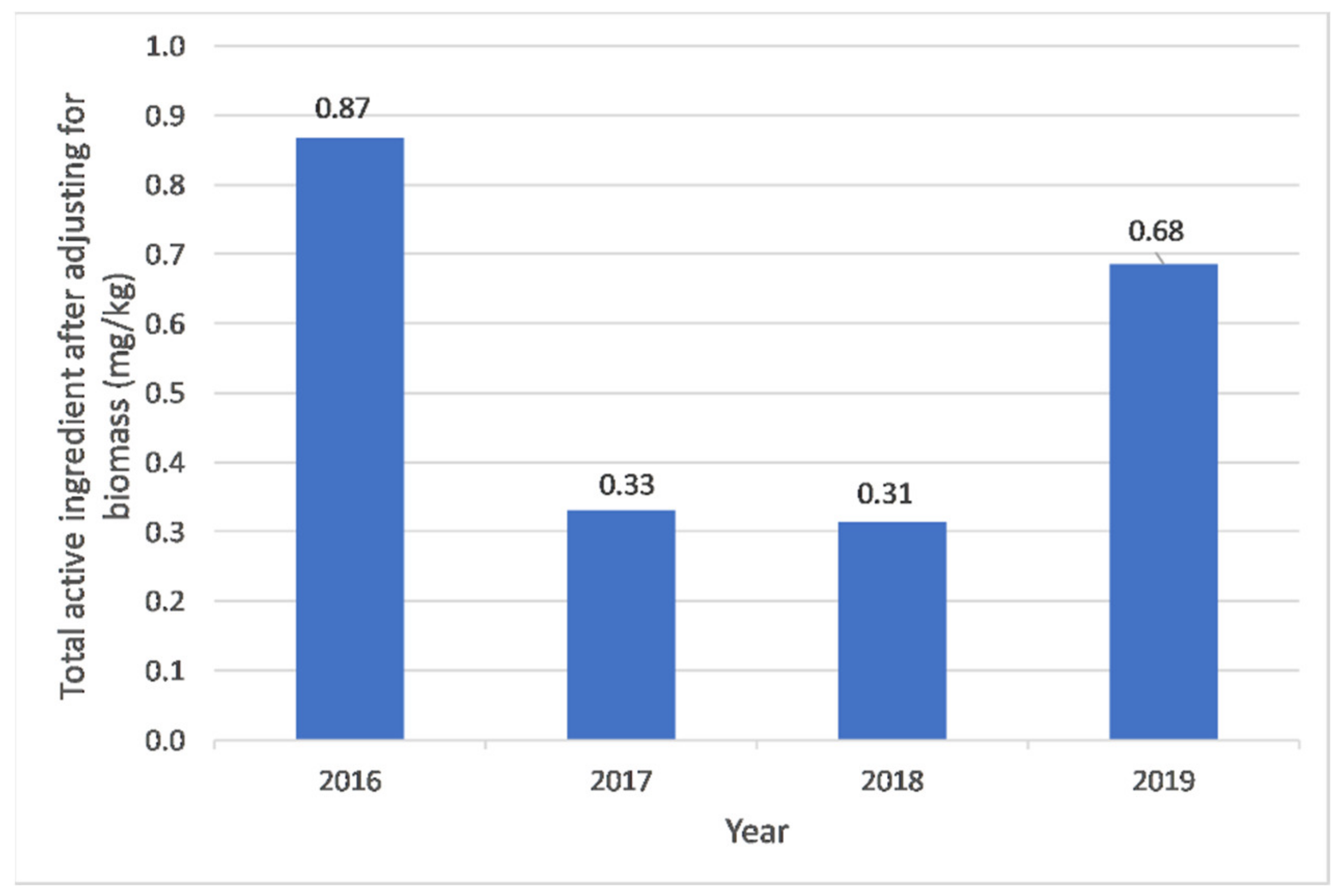
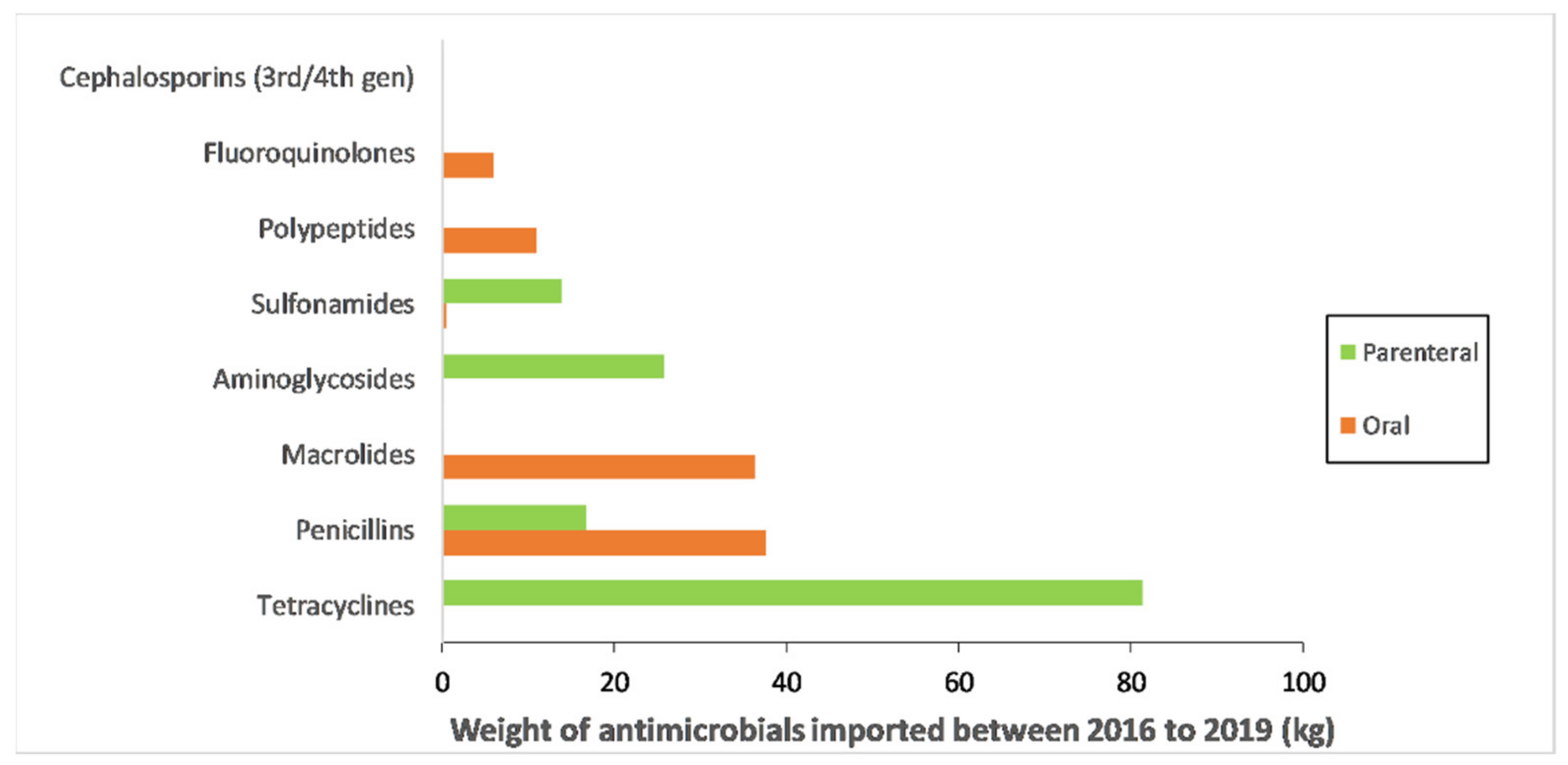
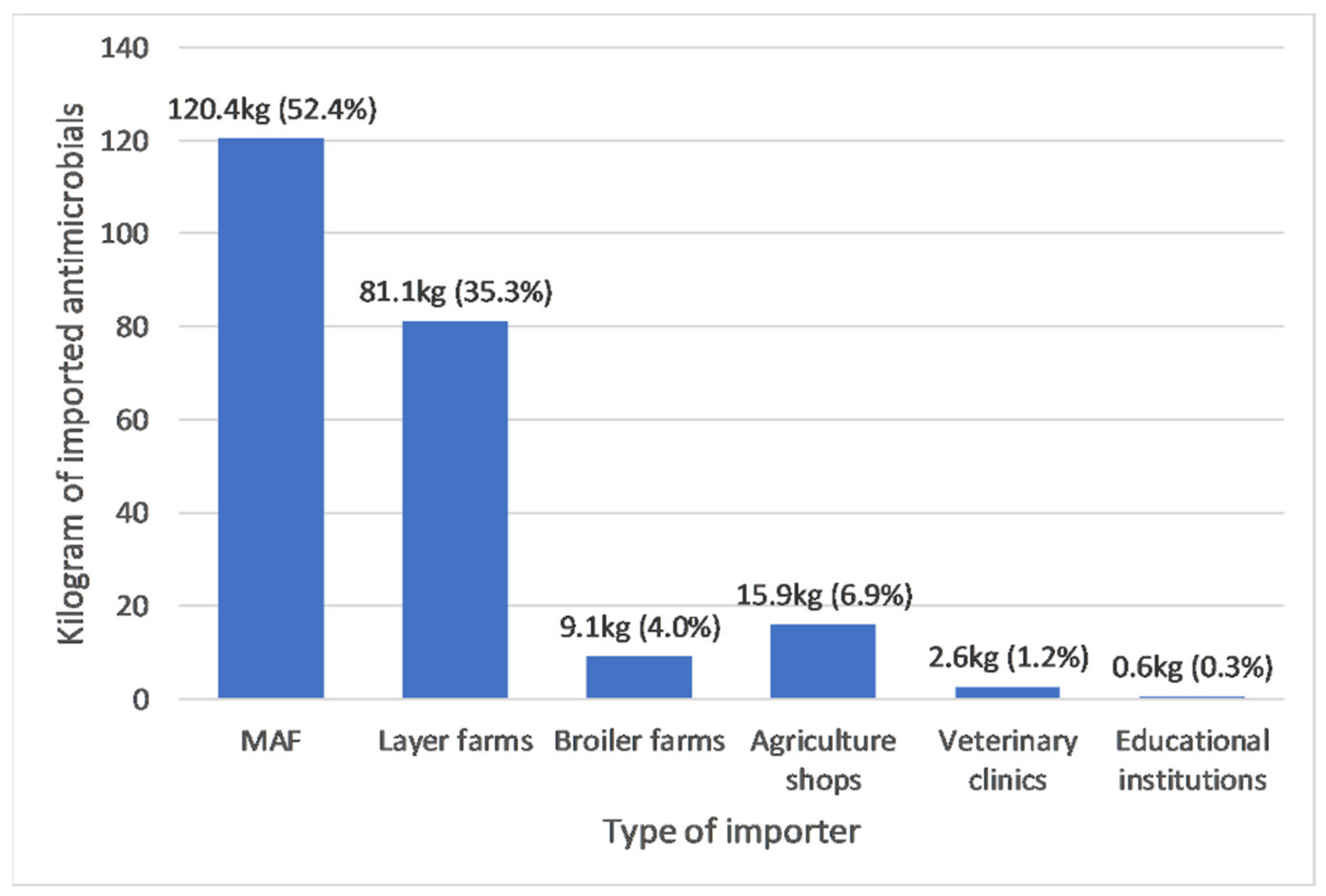
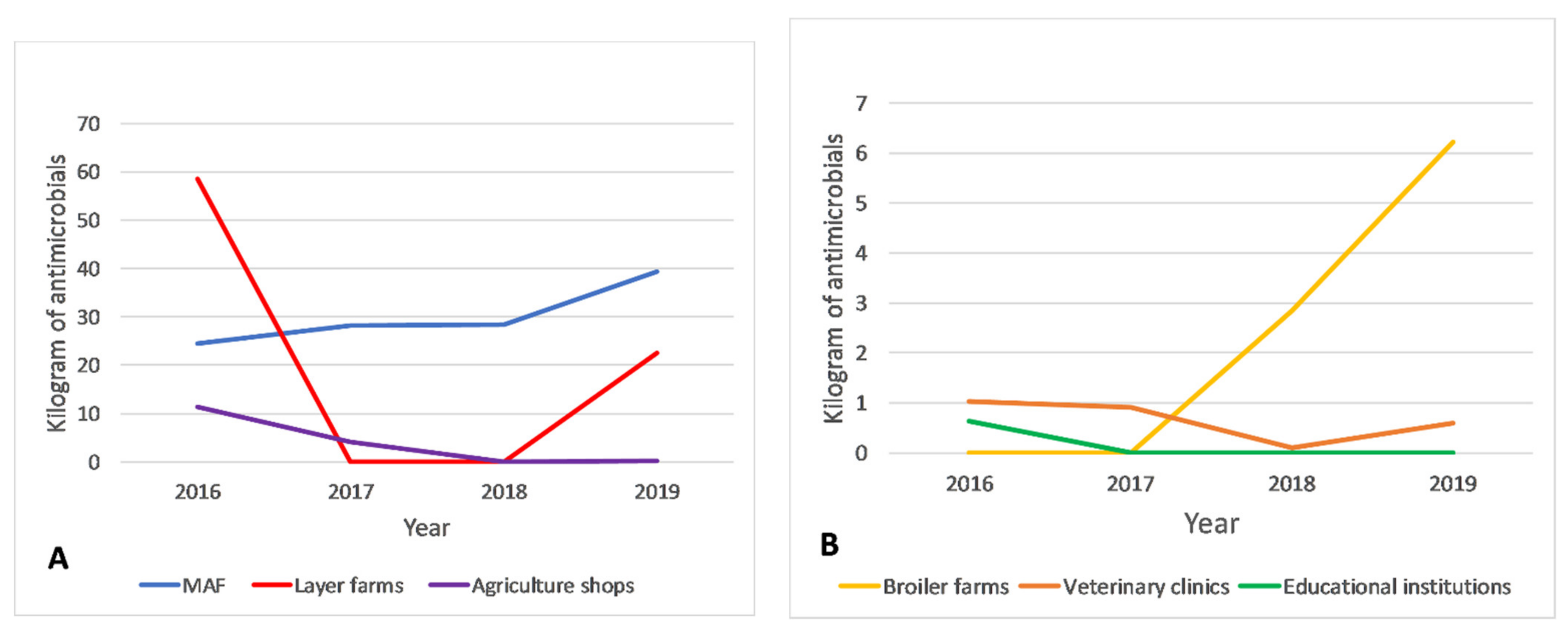
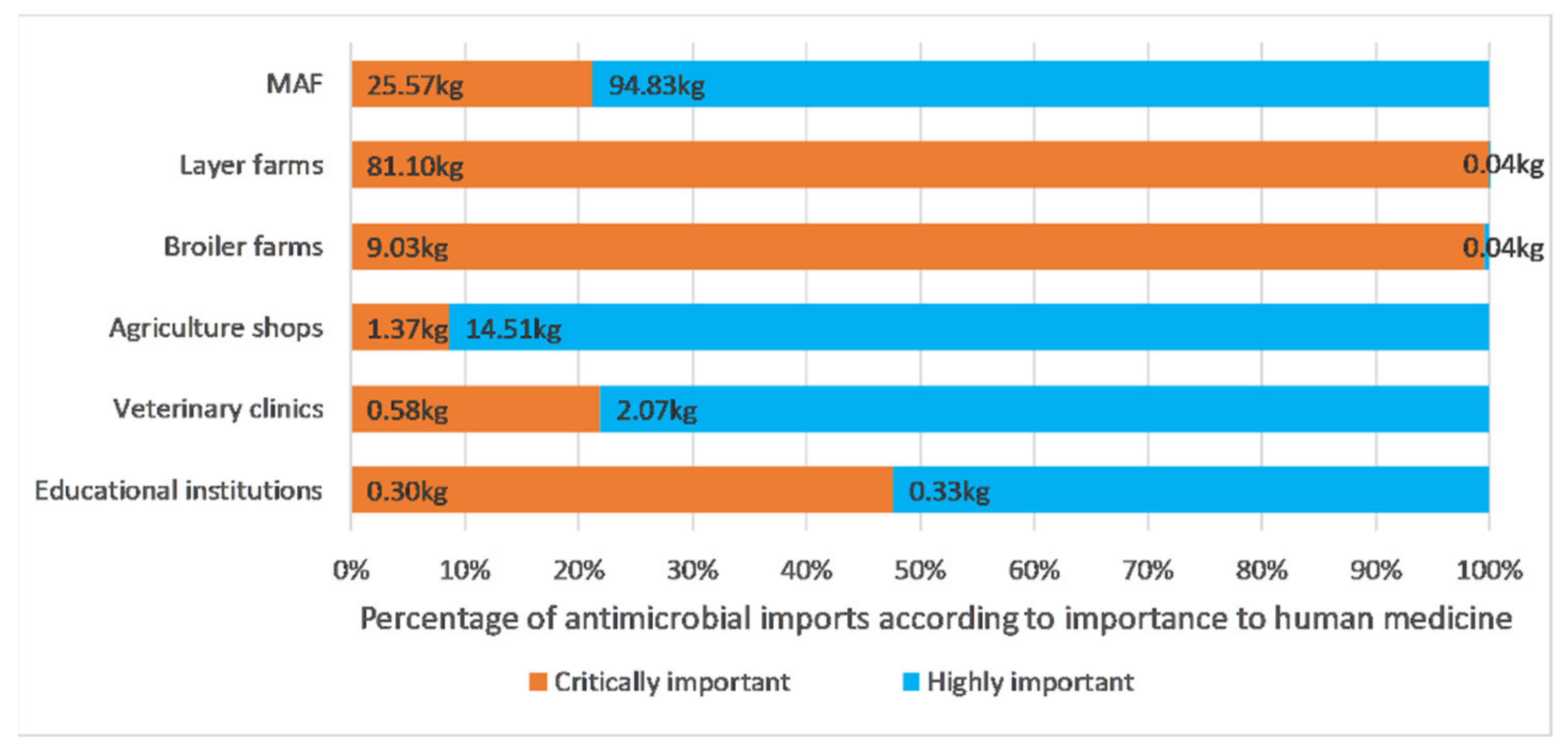
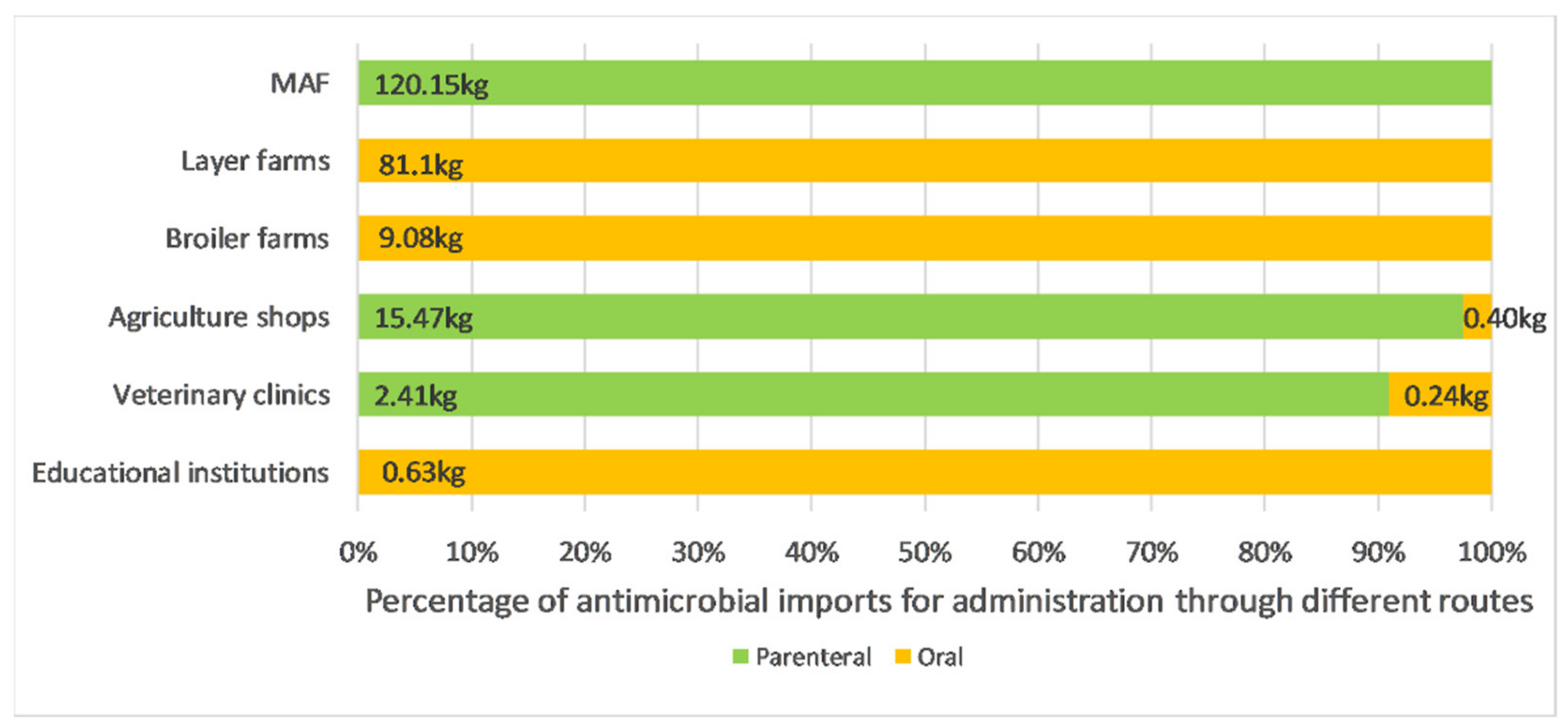
| Antimicrobial Class | Antimicrobial (WHO Classification 1) | Kilogram of Active Ingredient (%) | rs (p Value) 2 | Kilogram for all Years (%) | Kilogram for all Years for Each Class (%) | |||
|---|---|---|---|---|---|---|---|---|
| 2016 | 2017 | 2018 | 2019 | |||||
| Aminoglycosides | Neomycin (CIA) | 0 | 2.5×10−4 (<0.01) | 0.01 (0.05) | 0.01 (0.02) | 0.95 (0.05) | 0.03 (0.01) | 25.85 (11.25) |
| Dihydrostreptomycin (CIA) | 4.64 (4.83) | 6.20 (18.56) | 5.80 (18.5) | 9.18 (13.32) | 0.80 (0.20) | 25.82 (11.24) | ||
| Cephalosporins (3rd/4th gen) | Cefotaxime (CIA) | 0 | 0.01 (0.03) | 0 | 0 | −0.26 (0.74) | 0.01 (<0.00) | 0.01 (<0.00) |
| Fluroquinolones | Norfloxacin (CIA) | 0.20 (0.21) | 0.20 (0.60) | 0 | 0 | −0.89 (0.11) | 0.40 (0.17) | 6.01 (2.62) |
| Enrofloxacin (CIA) | 3.61 (3.76) | 0 | 0 | 2.00 (2.90) | −0.32 (0.68) | 5.61 (2.44) | ||
| Macrolides | Tylosin (CIA) | 25.10 (26.12) | 0.10 (0.30) | 0 | 0 | −0.95 (0.05) | 25.20 (10.97) | 36.45 (15.86) |
| Tilmicosin (CIA) | 0 | 0 | 0 | 11.25 (16.33) | 0.77 (0.23) | 11.25 (4.9) | ||
| Penicillins | Ampicillin (CIA) | 0 | 0 | 3.27 (10.41) | 0.63 (0.91) | 0.74 (0.26) | 3.89 (1.69) | 54.39 (23.67) |
| Benzylpenicillin (HIA) | 2.78 (2.90) | 3.72 (11.13) | 3.48 (11.10) | 5.70 (8.28) | 0.80 (0.20) | 15.69 (6.83) | ||
| Amoxicillin (CIA) | 20.31 (21.13) | 0 | 0 | 14.51 (21.05) | −0.32 (0.68) | 34.82 (15.15) | ||
| Polypeptides | Bacitracin (IA) | 0 | 0 | 0.02 (0.06) | 0 | 0.26 (0.74) | 0.02 (0.01) | 10.93 (4.76) |
| Colistin (CIA) | 10.04 (10.45) | 0 | 0.31 (0.98) | 0.57 (0.82) | −0.20 (0.80) | 10.91 (4.75) | ||
| Polymyxin B (CIA) | 0 | 9.5 × 10−5 (<0.01) | 0 | 0 | −0.26 (0.74) | 9.5 × 10−5 (<0.01) | ||
| Sulfonamides | Sulfamonomethoxine (HIA) | 0.40 (0.42) | 0.20 (0.60) | 0 | 0 | −0.95 (0.05) | 0.60 (0.26) | 14.46 (6.29) |
| Sulfaquinoxaline (HIA) | 0.33 (0.34) | 0 | 0 | 0 | −0.77 (0.23) | 0.33 (0.14) | ||
| Sulfadoxine (HIA) | 0 | 0 | 0 | 0.04 (0.06) | 0.77 (0.23) | 0.04 (0.02) | ||
| Sulfamerazine (HIA) | 0 | 0.08 (0.23) | 0.02 (0.06) | 0.78 (1.14) | 0.80 (0.20) | 0.88 (0.38) | ||
| Sulfadiazine (HIA) | 2.09 (2.17) | 1.48 (4.42) | 1.59 (5.06) | 1.57 (2.27) | −0.40 (0.60) | 6.72 (2.92) | ||
| Sulfadimidine (HIA) | 1.67 (1.74) | 0.58 (1.73) | 0.80 (2.56) | 2.35 (3.41) | 0.40 (0.60) | 5.40 (2.35) | ||
| Trimethoprim (HIA) | 0.20 (0.21) | 0.28 (0.84) | 0 | 0.01 (0.01) | −0.06 (0.40) | 0.49 (0.21) | ||
| Tetracyclines | Oxytetracycline (HIA) | 24.73 (25.73) | 20.56 (61.55) | 16.07 (51.23) | 20.32 (29.48) | −0.80 (0.20) | 81.67 (35.54) | 81.67 (35.54) |
| Overall | 96.1 (100) | 33.41 (100) | 31.36 (100) | 68.91 (100) | −0.40 (0.60) | 229.77 (100) | 229.77 (100) | |
Publisher’s Note: MDPI stays neutral with regard to jurisdictional claims in published maps and institutional affiliations. |
© 2021 by the authors. Licensee MDPI, Basel, Switzerland. This article is an open access article distributed under the terms and conditions of the Creative Commons Attribution (CC BY) license (https://creativecommons.org/licenses/by/4.0/).
Share and Cite
Ting, S.; Pereira, A.; Alves, A.d.J.; Fernandes, S.; Soares, C.d.C.; Soares, F.J.; Henrique, O.d.C.; Davis, S.; Yan, J.; Francis, J.R.; et al. Antimicrobial Use in Animals in Timor-Leste Based on Veterinary Antimicrobial Imports between 2016 and 2019. Antibiotics 2021, 10, 426. https://doi.org/10.3390/antibiotics10040426
Ting S, Pereira A, Alves AdJ, Fernandes S, Soares CdC, Soares FJ, Henrique OdC, Davis S, Yan J, Francis JR, et al. Antimicrobial Use in Animals in Timor-Leste Based on Veterinary Antimicrobial Imports between 2016 and 2019. Antibiotics. 2021; 10(4):426. https://doi.org/10.3390/antibiotics10040426
Chicago/Turabian StyleTing, Shawn, Abrao Pereira, Amalia de Jesus Alves, Salvador Fernandes, Cristina da Costa Soares, Felix Joanico Soares, Onofre da Costa Henrique, Steven Davis, Jennifer Yan, Joshua R. Francis, and et al. 2021. "Antimicrobial Use in Animals in Timor-Leste Based on Veterinary Antimicrobial Imports between 2016 and 2019" Antibiotics 10, no. 4: 426. https://doi.org/10.3390/antibiotics10040426
APA StyleTing, S., Pereira, A., Alves, A. d. J., Fernandes, S., Soares, C. d. C., Soares, F. J., Henrique, O. d. C., Davis, S., Yan, J., Francis, J. R., Barnes, T. S., & Jong, J. B. d. C. (2021). Antimicrobial Use in Animals in Timor-Leste Based on Veterinary Antimicrobial Imports between 2016 and 2019. Antibiotics, 10(4), 426. https://doi.org/10.3390/antibiotics10040426







